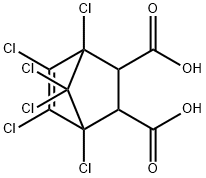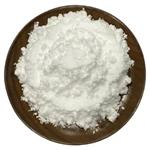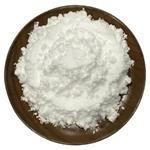Chemical Properties
Chlorendic acid is a colorless crystalline solid.
Uses
Hexachlorobicyclo[2.?2.1]?hept-?5-?ene-?2,?3-?dicarboxylic Acid is a novel flame retardant (NFR) which has also been observed as a toxic and environmental pollutant. Chlorinated Reactive Flame Retardant IntermediateEnvironmental toxin on US EPA Toxic Release Inventory list (TRI) list.
Uses
Chlorendic acid is used as a flame retardant in polyurethane foams, resins, plasticizers, coatings, epoxy resins, and wool fabrics; in the manufacture of alkyl resins for special paints and inks; in the manufacture of polyester resins with special applications in electrical systems,paneling, engineering plastics, and paint; and in the manufacture of corrosion-resistant tanks, piping, and scrubbers. Chlorendic acid is also used as an extreme-pressure lubricant (NTP 1987, IARC 1990, IPCS 1996, HSDB 2009).
Definition
ChEBI: A bridged organochlorine compound resulting from the Diels-Alder reaction of hexachlorocyclopentadiene with maleic anhydride followed by hydrolysis of the resulting anhydride. A chemical intermediate used in the preparation of fire-retardant polyester resi
s and plasticisers.
General Description
Fine white free-flowing crystals or white powder. Odorless.
Air & Water Reactions
Insoluble in water.
Reactivity Profile
Chlorendic acid readily forms salts with a variety of metals .
Fire Hazard
Chlorendic acid will burn when subject to direct flame, but is self-extinguishing when the flame is removed.
Safety Profile
Confirmed carcinogen
with experimental carcinogenic data. A
severe eye and mild skin irritant. When
heated to decomposition it emits toxic
fumes of Cl-.
Potential Exposure
Chlorendic acid is used to make other
chemicals, polyester resins; in fiberglass reinforced resins;
used for anticorrosion equipment and flame retardant applications of fabrics
Carcinogenicity
Chlorendic acid is reasonably anticipated to be a human carcinogenbased on sufficient evidence of carcinogenicity from studies in experimental animals.
Shipping
UN2928 Toxic solids, corrosive, organic, n.o.s.,
Hazard Class: 6.1; Labels: 6.1-Poisonous materials,
8-Corrosive material, Technical Name Required.
Incompatibilities
Compounds of the carboxyl group react
with all bases, both inorganic and organic (i.e., amines)
releasing substantial heat, water, and a salt that may be
harmful. Incompatible with arsenic compounds (releases
hydrogen cyanide gas), diazo compounds, dithiocarbamates, isocyanates, mercaptans, nitrides, sulfides (releasing
heat, toxic, and possibly flammable gases), thiosulfates,
and dithionites (releasing hydrogen sulfate and oxides of
sulfur).
Waste Disposal
Dispose of contents and container to an approved waste disposal plant. All federal, state,
and local environmental regulations must be observed.





